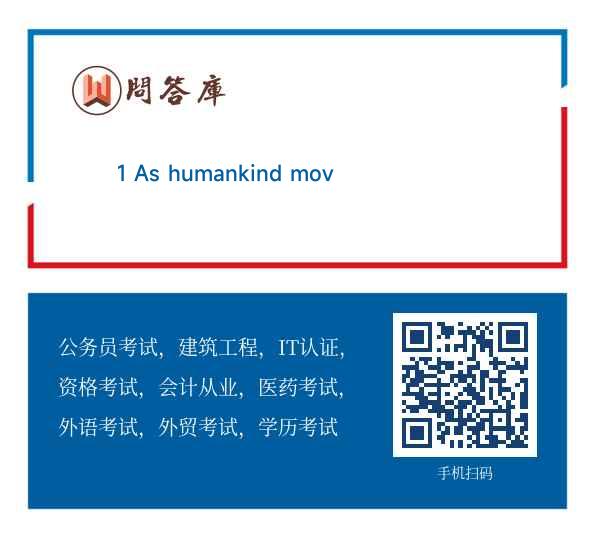1 As humankind moves into the third millennium
问题详情
1 As humankind moves into the third millennium, it can rightfully claim to have broken new ground in its age-old quest to master the environment. The fantastic achievements of modern technology and the speed at which scientific discoveries are translated into technological applications attest to the triumph of human endeavour.
2 At the same time, however, some of these applications threaten to unleash forces over which we have no control. In other words, the new technology Man now believes allows him to dominate this wider cosmos could well be a Frankenstein monster waiting to turn on its master.
3 This is an entirely new situation that promises to change many of the perceptions governing life on the planet. The most acute challenges facing the future are likely to be not only those pitting man against his fellow man, but those involving humankind"s struggle to preserve the environment and ensure the sustainability of life on earth.
4 A conflict waged to ensure the survival of the human species is bound to bring humans closer together. Technological progress has thus proved to be a double-edged sword, giving rise to a new form. of conflict: a clash between Man and Nature.
5 The new conflict is more dangerous than the traditional one between man and his fellow man, where the protagonists at least shared a common language. But when it comes to the reactions of the ecosystems to the onslaught of modern technology, there is no common language.
6 Nature reacts with weather disturbances, with storms and earthquakes, with mutant viruses and bacteria—that is, with phenomena having no apparent cause and effect relationship with the modern technology that supposedly triggers them.
7 As technology becomes ever more potent and Nature reacts ever more violently, there is an urgent need to rethink how best to deal with the growing contradictions between Man and Nature.
8 For a start, the planet, and hence all its inhabitants, must be perceived as an integral whole, not as a dichotomous mass divided geographically into the rich and developed and the poor and underdeveloped.
9 Today, globalization encompasses the whole world and deals with it as an integral unit. It is no longer possible to say that conflict has shifted from its traditional east-west axis to a north-south axis. The real divide today is between summit and base, between the higher echelons of the international political structure and its grassroots level, between governments and NGOs, between state and civil society, between public and private enterprise.
10 The mesh structure is particularly obvious on the Internet. While it is true that to date the Internet seems to be favouring the most developed sectors of the international community over the less developed, this need not always be the case. Indeed, it could eventually overcome the disparities between the privileged and the underdeveloped.
11 On the other hand, the macro-world in which we live is exposed to distortions because of the unpredictable side-effects of a micro-world we do not and cannot totally control.
12 This raises the need for a global system of checks and balances, for mandatory rules and constraints in our dealings with Nature, in short, for a new type of veto designed to manage what is increasingly becoming a main contradiction of our time: the one between technology and ecology.
13 A new type of international machinery must be set in place to cope with the new challenges. We need a new look at the harnessing of scientific discoveries, to maximize their positive effects for the promotion of humanity as a whole and to minimize their negative effects. We need an authority with veto powers to forbid practices conducive to decreasing the ozone hole, the propagation of AIDS, global warming, desertification—an auth
A.a new form. of conflict.
B.Man"s creative powers.
C.the role of modern technology.
D.Man"s ground-breaking work.
参考答案
正确答案:A
解析:<1>break ground此处表示“取得巨大进展”。
<2>The fantastic achievements of modern technology and the speed at which scientificdiscoveries are translated into technological applications attest to the triumph of human endeavour.此处translate表示“转化为”,attest to表示“证明”、“表明”。
<3>unleash发生,发动,释放
<4>...the new technology Man now believes allows him to dominate this wider cosmos could well be a Frankenstein monster waiting to turn on its master. Man now believes allows him to dominate this wider cosmos为定语从句,修饰the new technology,在technology与Man之间一般要有引导词that或which。Man now believes为插入成分。Frankenstein monster此处为一典故。Frankenstein是一个创造怪物而自己被它毁灭的医学研究者,是英国女作家Mary W.Shelly于1818所著同名小说中的主人公。现它广泛用来指那些作法自毙者。此处作者将威胁人类生存环境的科学技术比作Frankenstein发明的那个怪物。turn on sb.表示“转身攻击”、“突然袭击”。
<5>pitting man agains this fellow man此分词短语作定语,修饰those(代指challenge)。pit A against B表示“使A与B对立、相斗或冲突”。
<6>dichotomous mass可被一分为二的整体
<7>echelon阶层,系统中的等级
<8>NGO non-governmental organization,非政府组织的缩写
<9>mesh structure网状结构
<10>veto否决,否决权
<11>We need an authority with veto powers to forbid practices conducive to decreasing the ozone hole,the propagation of AIDS,global warming,desertification...conducive to...desertification这一形容词短语作practices的后置定语。conducive to sth.表示“易导致……的”、“助长……的”。ozone hole表示“臭氧层空洞”。 propagation表示“蔓延”、“扩展”。
<12>the UN in its present form. in its present form这一介词短语做UN的后置定语。
此题为一般推理题。从后文来看,尽管现代技术在征服自然方面贡献巨大,但同时也带有一些新的问题(尤其第2段),所以B、C、D均不妥。
